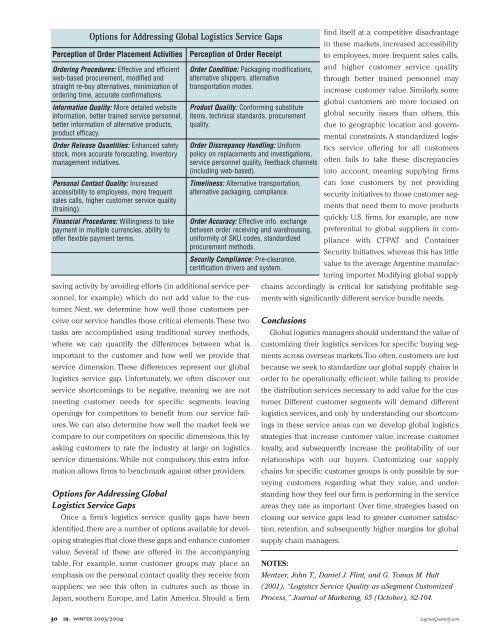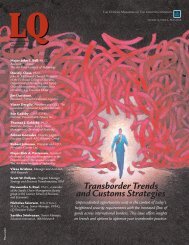Reverse Logistics - Logistics Quarterly
Reverse Logistics - Logistics Quarterly
Reverse Logistics - Logistics Quarterly
You also want an ePaper? Increase the reach of your titles
YUMPU automatically turns print PDFs into web optimized ePapers that Google loves.
Options for Addressing Global <strong>Logistics</strong> Service Gaps<br />
find itself at a competitive disadvantage<br />
in these markets, increased accessibility<br />
Perception of Order Placement Activities Perception of Order Receipt<br />
to employees, more frequent sales calls,<br />
Ordering Procedures: Effective and efficient Order Condition: Packaging modifications, and higher customer service quality<br />
web-based procurement, modified and alternative shippers, alternative<br />
through better trained personnel may<br />
straight re-buy alternatives, minimization of<br />
ordering time, accurate confirmations.<br />
Information Quality: More detailed website<br />
information, better trained service personnel,<br />
transportation modes.<br />
Product Quality: Conforming substitute<br />
items, technical standards, procurement<br />
increase customer value. Similarly, some<br />
global customers are more focused on<br />
global security issues than others, this<br />
better information of alternative products, quality.<br />
due to geographic location and govern-<br />
product efficacy.<br />
mental constraints. A standardized logis-<br />
Order Release Quantities: Enhanced safety<br />
stock, more accurate forecasting, inventory<br />
management initiatives.<br />
Order Discrepancy Handling: Uniform<br />
policy on replacements and investigations,<br />
service personnel quality, feedback channels<br />
tics service offering for all customers<br />
often fails to take these discrepancies<br />
(including web-based).<br />
into account, meaning supplying firms<br />
Personal Contact Quality: Increased Timeliness: Alternative transportation, can lose customers by not providing<br />
accessibility to employees, more frequent<br />
sales calls, higher customer service quality<br />
(training).<br />
alternative packaging, compliance. security initiatives to those customer segments<br />
that need them to move products<br />
Financial Procedures: Willingness to take<br />
payment in multiple currencies, ability to<br />
Order Accuracy: Effective info. exchange<br />
between order receiving and warehousing,<br />
quickly. U.S. firms, for example, are now<br />
preferential to global suppliers in com-<br />
offer flexible payment terms.<br />
uniformity of SKU codes, standardized<br />
procurement methods.<br />
pliance with CT-PAT and Container<br />
Security Initiatives, whereas this has little<br />
Security Compliance: Pre-clearance,<br />
certification drivers and system.<br />
value to the average Argentine manufacturing<br />
importer. Modifying global supply<br />
saving activity by avoiding efforts (in additional service per- chains accordingly is critical for satisfying profitable segsonnel,<br />
for example) which do not add value to the customer.<br />
Next, we determine how well those customers perments<br />
with significantly different service bundle needs.<br />
ceive our service handles those critical elements.These two Conclusions<br />
tasks are accomplished using traditional survey methods, Global logistics managers should understand the value of<br />
where we can quantify the differences between what is customizing their logistics services for specific buying seg-<br />
important to the customer and how well we provide that ments across overseas markets.Too often,customers are lost<br />
service dimension. These differences represent our global because we seek to standardize our global supply chains in<br />
logistics service gap. Unfortunately, we often discover our order to be operationally efficient, while failing to provide<br />
service shortcomings to be negative, meaning we are not the distribution services necessary to add value for the cus-<br />
meeting customer needs for specific segments, leaving tomer. Different customer segments will demand different<br />
openings for competitors to benefit from our service fail- logistics services, and only by understanding our shortcomures.<br />
We can also determine how well the market feels we ings in these service areas can we develop global logistics<br />
compare to our competitors on specific dimensions, this by strategies that increase customer value, increase customer<br />
asking customers to rate the industry at large on logistics loyalty, and subsequently increase the profitability of our<br />
service dimensions. While not compulsory, this extra infor- relationships with our buyers. Customizing our supply<br />
mation allows firms to benchmark against other providers. chains for specific customer groups is only possible by surveying<br />
customers regarding what they value, and under-<br />
Options for Addressing Global<br />
standing how they feel our firm is performing in the service<br />
<strong>Logistics</strong> Service Gaps<br />
areas they rate as important. Over time, strategies based on<br />
Once a firm’s logistics service quality gaps have been closing our service gaps lead to greater customer satisfac-<br />
identified,there are a number of options available for develtion, retention, and subsequently higher margins for global<br />
oping strategies that close these gaps and enhance customer<br />
value. Several of these are offered in the accompanying<br />
supply chain managers.<br />
table. For example, some customer groups may place an NOTES:<br />
emphasis on the personal contact quality they receive from Mentzer, John T., Daniel J. Flint, and G. Tomas M. Hult<br />
suppliers: we see this often in cultures such as those in (2001), “<strong>Logistics</strong> Service Quality as aSegment Customized<br />
Japan, southern Europe, and Latin America. Should a firm Process,” Journal of Marketing, 65 (October), 82-104.<br />
30 LQ winter 2003/2004<br />
<strong>Logistics</strong><strong>Quarterly</strong>.com







